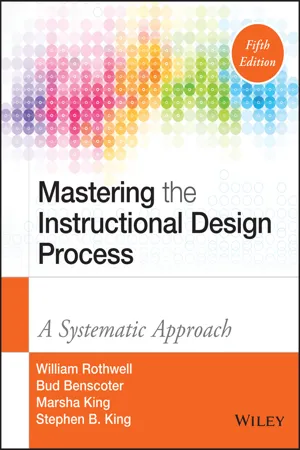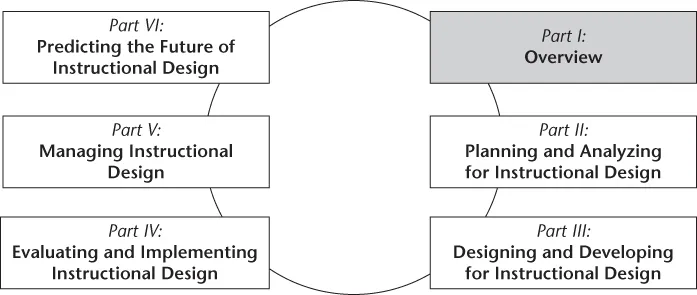
Mastering the Instructional Design Process
A Systematic Approach
William J. Rothwell, Bud Benscoter, Marsha King, Stephen B. King
- English
- ePUB (mobile friendly)
- Available on iOS & Android
Mastering the Instructional Design Process
A Systematic Approach
William J. Rothwell, Bud Benscoter, Marsha King, Stephen B. King
About This Book
A comprehensive framework for effective real-world instructional design
Mastering the Instructional Design Process provides step-by-step guidance on the design and development of an engaging, effective training program. The focus on core competencies of instructional system design helps you develop your skills in a way that's immediately applicable to real-world settings, and this newly updated fifth edition has been revised to reflect the new IBSTPI Competencies and Standards for Instructional Design. With a solid foundation of researched and validated standards, this invaluable guide provides useful insight and a flexible framework for approaching instructional design from a practical perspective. Coverage includes the full range of design considerations concerning the learners, objectives, setting, and more, and ancillaries include design templates, PowerPoint slides, lecture notes, and a test bank help you bring these competencies to the classroom.
Instructional design is always evolving, and new trends are emerging to meet the ever-changing needs of learners and exploit the newest tools at our disposal. This book brings together the latest developments and the most effective best practices to give you a foolproof framework for successfully managing instructional design projects.
- Detect and solve human performance problems
- Analyze needs, learners, work settings, and work
- Establish performance objectives and measurements
- Deliver effective instruction in a variety of scenarios
Effective training programs don't just happen. Instructional design is a complex field, and practitioners must be skilled in very specific areas to deliver a training program that engages learners and makes the learning 'stick.' Mastering the Instructional Design Process is a comprehensive handbook for developing the skillset that facilitates positive training outcomes.
Frequently asked questions
Part One
Overview

Chapter One
An Overview of Instructional Design
Exhibit 1.1: Ten Key Assumptions about Instructional Design and Instructional Design Competencies
- Assumption 1: Instructional designers are those persons who demonstrate design competencies on the job regardless of their job title or training.
- Assumption 2: Instructional design (ID) competencies pertain to persons working in a wide range of settings.
- Assumption 3: Instructional design is a process most commonly guided by systematic design models and principles.
- Assumption 4: Instructional design is most commonly seen as resulting in transfer of training and organizational performance improvement.
- Assumption 5: Instructional design competence spans novice, experienced, and expert designers.
- Assumption 6: Few instructional designers, regardless of their levels of expertise, are able to successfully demonstrate all ID competencies.
- Assumption 7: ID competencies are generic and amenable to customization.
- Assumption 8: ID competencies define the manner in which design should be practiced.
- Assumption 9: ID competencies reflect societal and disciplinary values and ethics.
- Assumption 10: ID competencies should be meaningful and useful to designers worldwide.